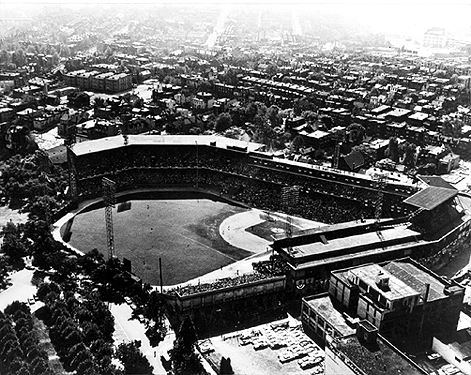

Forbes Field Opening: 35,000 Fans Help to Dedicate Ball Park: Largest Assemblage Ever Gathered in Any Ball Park Anywhere Enjoys Ideal Weather Conditions, June 30, 1909. (68)
In Forbes Quadrangle, a huge university [of Pittsburgh] building that houses classrooms and administrative offices, the home plate from the field's final game--Bucs vs. Chicago Cubs--is preserved under Lucite on the ground floor. (69)
Center Field Plaza, located adjacent to the University of
Pittsburgh campus, commemorates the site of old Forbes Field. It consists
of a parklet, sections of the old center field wall, a brick walkway
outlining the left field wall, benches made of bricks from the walls, and
a flag pole on the site of the original Forbes Field flag pole.
Two plaques are to be embedded in the Plaza. They read:
This line of bricks marks the outfield wall of old Forbes Field which served as the home of the Pittsburgh Pirates from June 30, 1909 until June 28, 1970, when the new Three Rivers Stadium opened.
This marks the spot where Bill Mazeroski's home run ball cleared the left center field wall of Forbes Field on October 13, 1960, thereby winning the World Series championship for the Pittsburgh Pirates. The historic hit came in the ninth inning of the seventh game, to beat the New York Yankees by a score of 10-9.The flag to be raised over the Plaza was flown over the United States Capitol Building in Washington, D. C. (70)
And the Pirate bullpen was almost within touching distance; you could see the players almost face to face; you could talk to them--and they'd talk to you. And one night, a teen-age boy's school chum kept badgering the relievers to let him don one of their warmup jackets--and Bob Veale obliged. The chum swam in it, but he was a celebrity for a week, at least. (71)
Forbes Field is named in honor of that stern old Scot, General
Forbes, who not only gave Pittsburgh its name by wresting Fort Duquesne
from the French and calling it Fort Pitt, but who also, very
considerately for the Forbes Field enterprise, acquired the somewhat
metallic sobriquet of "Old Ironhead."
And yet, iron is not all that goes to make Forbes Field remarkable.
Situated at the northwest corner of Schenley
Park,one of the most beautiful natural parks in this country, it
spreads its great iron wings--thirteen hundred and thirty-nine feet from
tip to tip--open to the south and the east upon a landscape fit for the
brush of any painter, even a master, as was demonstrated when that noted
English artist, Sir Alfred East, some years back chose for his canvas the
hollow that cuts its way through Schenley Park, for it is "Junction Hollow" that lies at the foot of Forbes
Field.
Forbes Field itself covers approximately seven acres formed into one of
the most beautiful and perfectly kept base ball diamonds in the world.
Sweeping around this playing field, seventy-four feet high and extending
thirteen hundred and thirty-nine feet from end to end, is the great
concrete and iron grandstand of Forbes Field, a giant structure into
which has been poured and fabricated 650 cars of sand and gravel, 110
cars of cement, 90 cars of brick, 130 cars of structural steel, 40 cars
of sewer pipe, glass, frames and elevator material, 40 cars ornamental
iron and 70 cars of chairs.
The Forbes Field stands were built in two section--the original layout
being erected in 1909 and the right and center field addition being added
in 1925.
The people of Pittsburgh have shown their
appreciation of the ball club's
efforts to provide the best to be had in the great American pastime by
substantial cooperation--hundreds of private boxes are held from year to
year by individuals and the greatest industrial, educational and
financial concerns of the district.
In the thirty-three years from 1901 to 1932, inclusive, the Pirates have
finished the season in the following positions in the National League
race:
First...................six times Second..................six times Third...................seven times Fourth..................seven times Second Division.........six timesIn twenty-six out of the thirty-three years the Pittsburgh Club finished fourth or better, which is a record bettered by only one other club in baseball--the Chicago Cubs.
Merely to sit in this wonderful stand, and rest the eye on the splendid expanse of emerald field, level as a billiard table, and covered with velvety turf, is a positive pleasure; but when the eye strays beyond it encounters a truly remarkable expanse of natural and architectural beauty. (73)
Pittsburgh surely has come into its own with the finest baseball field in the world. What the great athletic institution means to Oakland will be amply told in future years. It is a fixed opinion among Pittsburgh real estate men and capitalists that nothing could have brought a greater business impetus and development to that growing center. (74)